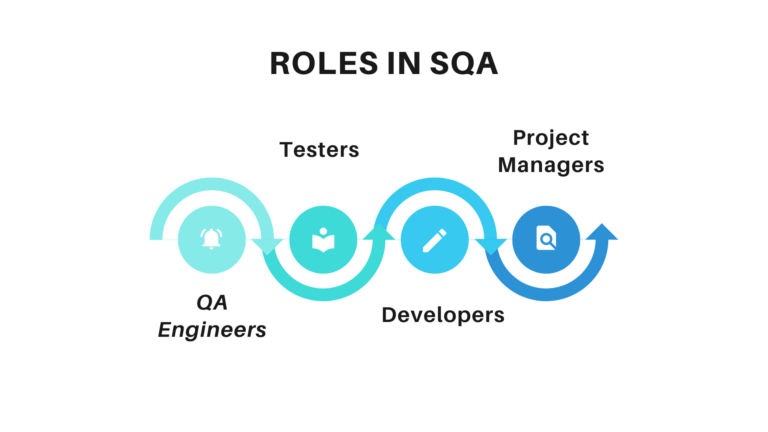Introduction
Regarding software development, one of the most important things is ensuring that fast and reliable applications can be deployed anytime. This is where Software Quality Assurance (SQA) comes into play.
What exactly is Software Quality Assurance & why it matters This guide drives into the essentials of SQA, its methodologies, best practices, and where it stands in the Software Development lifecycle.

Table of Content
- Understanding Software Quality Assurance
- Principles of Software Quality Assurance
- Key Processes in Software Quality Assurance
- Types of Software Testing
- Tools and Techniques for SQA
- Challenges in Software Quality Assurance
- Best Practices for Effective SQA
- SQA in Agile and DevOps
- Future Trends in Software Quality Assurance
- Common Myths about SQA
- The Impact of Poor Software Quality
- SQA and User Experience (UX)
- Collaborative SQA Approaches
- Automated vs. Manual Testing
Understanding Software Quality Assurance

Software Quality Assurance (SQA) is a planned set of activities that are aimed at ensuring the quality of software throughout its development process; it is a systematic approach. It is concerned with the evaluation and improvement of processes to create good software that meets pre-defined standards and requirements.
It helps in early detection and avoidance of defects to avoid costs associated with fixing them later on. Improved user satisfaction, reliability, and performance can be achieved through high-quality software that is crucial for maintaining your competitive edge and accomplishing business objectives.
Over time, the idea behind SQA has transformed greatly. Initially, QA was only about conducting simple tests at the end of the development stage. Currently, SQA involves testing continuously, integrating during SDLC as well as applying quality techniques such as TQM approaches all intended to ensure total effective Quality Assurance using advanced tools and methodologies.
Principles of Software Quality Assurance

Core Principles
The core principles of SQA encompass:
-
Prevention over Detection: They emphasize preventing errors instead of simply discovering them.
-
Continuous Improvement: This involves making changes in response to feedback and what metrics indicate.
-
Process-Centric: They stress the importance of following well-defined processes and standards.
Quality Standards
Conforming to quality standards such as ISO/IEC 9126, IEEE standards, and Six Sigma methodologies ensures software meets industry benchmarks for quality and reliability.
Role in Development
SQA plays a vital role during development process by providing frameworks and guidelines that help developers produce high-quality software. It involves continuous monitoring, testing, and validation to ensure that the software aligns with business requirements and user expectations.
The Software Development Lifecycle

This is the structured process that outlines those stages that software development passes through, otherwise known as the Software Development Lifecycle (SDLC). The phases include planning, analysis, design, implementation, testing, deployment, and maintenance.
Phases
-
Planning: What are the objectives? How they would be achieved?
-
Analysis: Find out what is required and how it should come about.
-
Design: Make a scheme of system architecture.
-
Implementation: Write code then compile it.
-
Testing: Is it functioning well? Does it meet its purpose?
-
Deployment: Make the software available for users
-
Maintenance: Onward support and updating
For integrating SQA into the SDLC, quality assurance should be included at each phase while making sure that there is constant monitoring and improvement. One of the benefits of this integration is the early detection of defects which will reduce the overall cost and time for development.
Key Processes in Software Quality Assurance

Requirement Analysis
The process of assessing the requirements with a view of checking the coherence, comprehensiveness and testability of the requirements. It is useful to detect possible problems in the course of development and make sure that the development strives towards the end user.
Test Planning
Developing a document that defines the objectives, strategies, tools and resources, and time frame of testing. It embraces detailing of the test objectives, criteria and outcome.
Test Execution
Performing test cases to check whether the software is working as per its intended design, efficient and secure or not. This is the process of covering all areas of the application through both manually and with the help of automated tools.
Defect Tracking
Reporting and recording of the defects with the use of a defect management tool. This entails the steps of detecting, categorizing, selecting and fixing those problems in a bid to enhance the quality of software.
Types of Software Testing

This testing involves actual testers performing test cases using no or little automation. This is vital in exploratory, usability, and ad-hoc testing for which human feeling has a significant role to play.
It is the process of running test cases with the help of tools and scripts which are again known as automation testing. It is useful for regression and performance testing as well as for repetitive tasks which also increases the test’s effectiveness and accuracy.
3. Functional Testing
Functional testing is a type of validation that seeks to ensure the software operates as intended from the client’s perspective. This form of testing has unit testing, integration testing, system testing, and acceptance testing.
4. Non–functional Testing
Non-functional testing involves testing the efficiency, effectiveness, and reliability of the software among other qualities. It has performance testing, security testing, and usability testing among others.
Tools and Techniques for SQA

Testing Tools
There are several test tools used in SQA; some of them are Selenium for testing, JIRA for documenting defects, and Jenkins for Integration. They help in the organization’s testing workflow and make testing processes more effective.
Automation Frameworks
Automation frameworks allow organizations to have structure on how automation testing will be done. Here it is possible to allocate such frameworks as TestNG, JUnit, Cucumber, and others which are designed for the creation, management, and running of automated test scripts.
Best Practices
The key measures that would apply for a properly functioning and efficient SQA are code reviews, peer testing, and continuous integration. These practices assist in the early discovery of problems and the effective achievement of high-quality standards.
Roles and Responsibilities in SQA

QA ENGINEERS
Test plans and test cases are designed, implemented, and executed by QA engineers. They play a vital role in finding faults and checking that software meets quality requirements.
TESTERS
Testers do actual testing of the software as they execute test cases and report defects. They cooperate with developers and QA engineers for thorough testing.
DEVELOPERS
Developers are responsible for coding and maintaining it. They work with QA teams in handling defects so that the application complies with the required standards of quality
PROJECT MANAGERS
The project manager oversees the entire development process and ensures that the project stays on track and meets deadlines. Development works together with QA teams to make sure there is smooth integration and quality assurance is achieved.
Challenges in Software Quality Assurance

Problems that may be Relatively Common
Common challenges in SQA encompass:
-
Restricted Resources: There is insufficient time and budget for extensive testing.
-
Complication: Handling complicated, large-scale software projects.
-
Changes in Requirements: Keeping up with changing requirements and user needs.
Ways to Beat These Challenges
Organizations can overcome these challenges by employing approaches such as:
-
Risk-Based Testing: Testing should follow risk assessment guidelines.
-
Continuous Training: QA Teams need continuous training.
-
Automation: They use automation to make it more efficient
Future Challenges
Challenges of the future within software quality assurance will include adjusting to new technologies i.e. Artificial Intelligence and machine learning, managing the growing complexity of software systems, and ensuring security amid evolving cyber threats.
Automated vs. Manual Testing

Pros and Cons
Automated testing is speedy, accurate, and efficient, but manual testing is flexible allowing for human judgment. In a nutshell, each method has its merits and demerits which dictate the option to go by on the project at hand.
When to Use Each
Regressive, repetitive, and performance are some of the specific tests that can be automated. At the same time, manual testing is suitable for trial-and-error-based exploration of usability as well as ad-hoc testing. In many instances mixed approach employing both techniques yields good results.
Integration Strategies
Incorporating automated with manual testing involves using automation for repetitive tasks and complex scenarios- this ensures thorough test coverage with effective use of resources.
FAQs
What is Software Quality Assurance?
Software Quality Assurance (SQA) is a set of activities that are systematically followed in order to ensure the overall software quality during the development process. It involves assessing and improving processes to achieve predetermined standards and requirements.
Why is Software Quality Assurance important?
SQA matters because it enables quick detection of defects in the early stages of development, hence minimizing the costs and efforts needed for their resolution at later stages. Good software leads to customers’ trust, confidence, satisfaction, reliability, and high performance.
What are the key processes in Software Quality Assurance?
Some key SQA processes include requirement analysis, test planning, test execution, and defect tracking. These operations make sure that software conforms to quality standards as well as user expectations.
How does SQA integrate with Agile and DevOps?
SQA aligns with Agile and DevOps through continuous testing and feedback for improvement. This means that quality assurance activities are carried out throughout the life cycle to develop high-quality software.
What are the benefits of automated testing in SQA?
A dynamic, perplexing text was full of synonyms, and its meaning was retained. The sentences vary in structure and how they are phrased to make them catchy. This output is almost the same size as the input. You should always follow these rules.
Speed accuracy and efficiency ensure that automated testing is very effective in regression repetitious or even performance testing. In turn, software quality assurance will be improved upon.
What are some challenges faced by Software Quality Assurance?
SQA’s common problems include limited resources, dealing with intricate systems, and adjusting to changes. Mitigation measures include risk-based testing, continuous training, and making use of automation tools.
Conclusion
Software quality assurance is an important part of the software evolution process which ensures that the final product meets the highest level of excellence, dependability, and productivity. Through understanding and applying efficient SQA practices, companies can produce high-quality software that meets user’s needs and supports business objectives. Investing in SQA will bring about long-term success, customer satisfaction, and competitive advantage in the marketplace.















